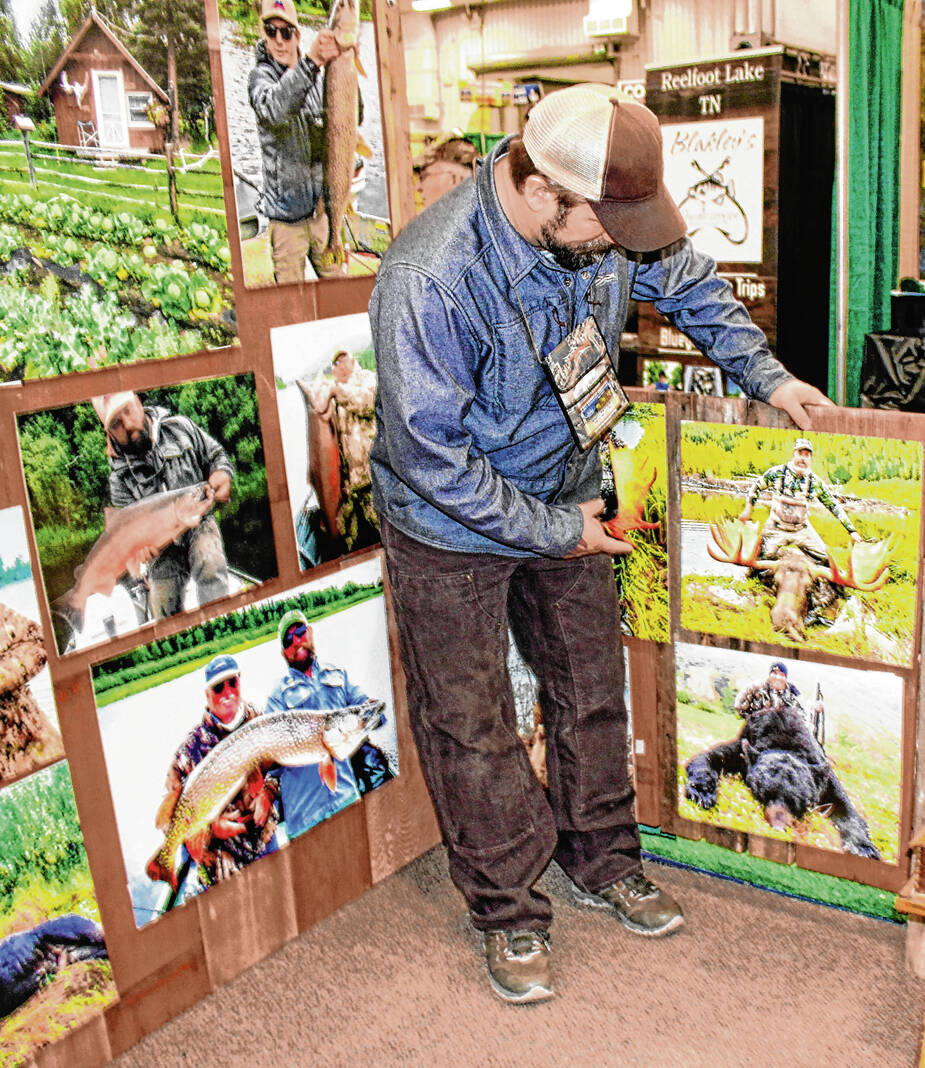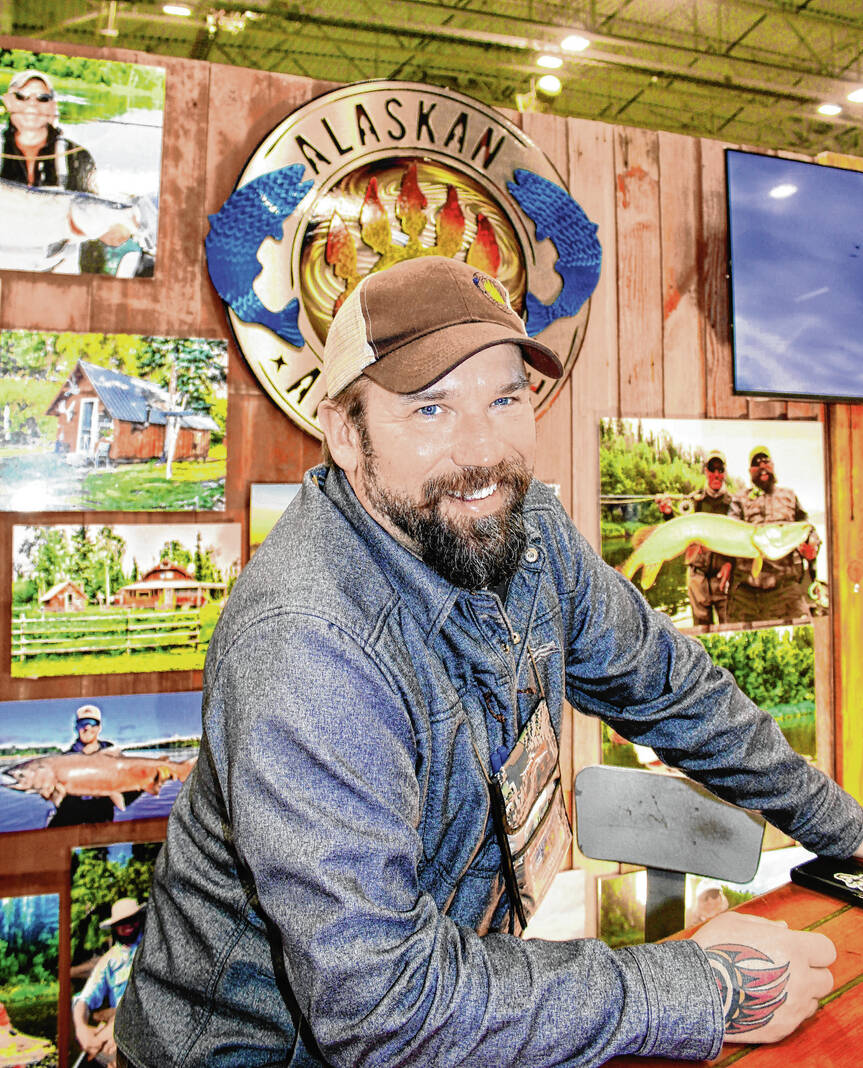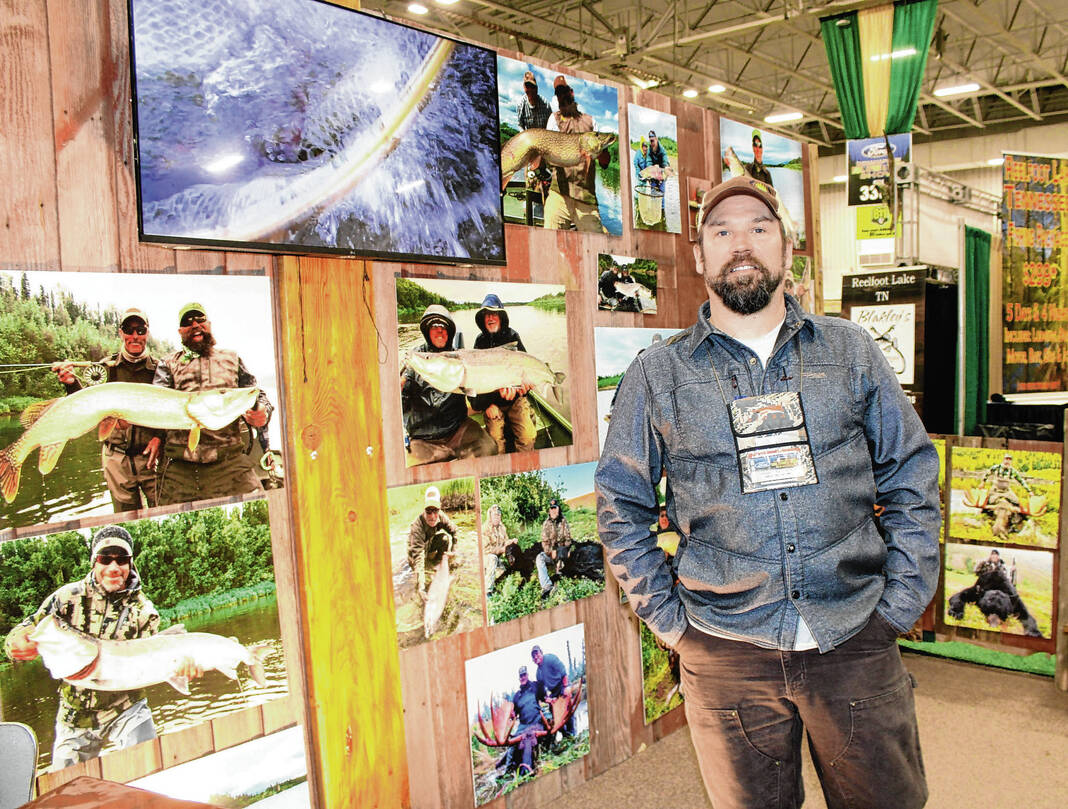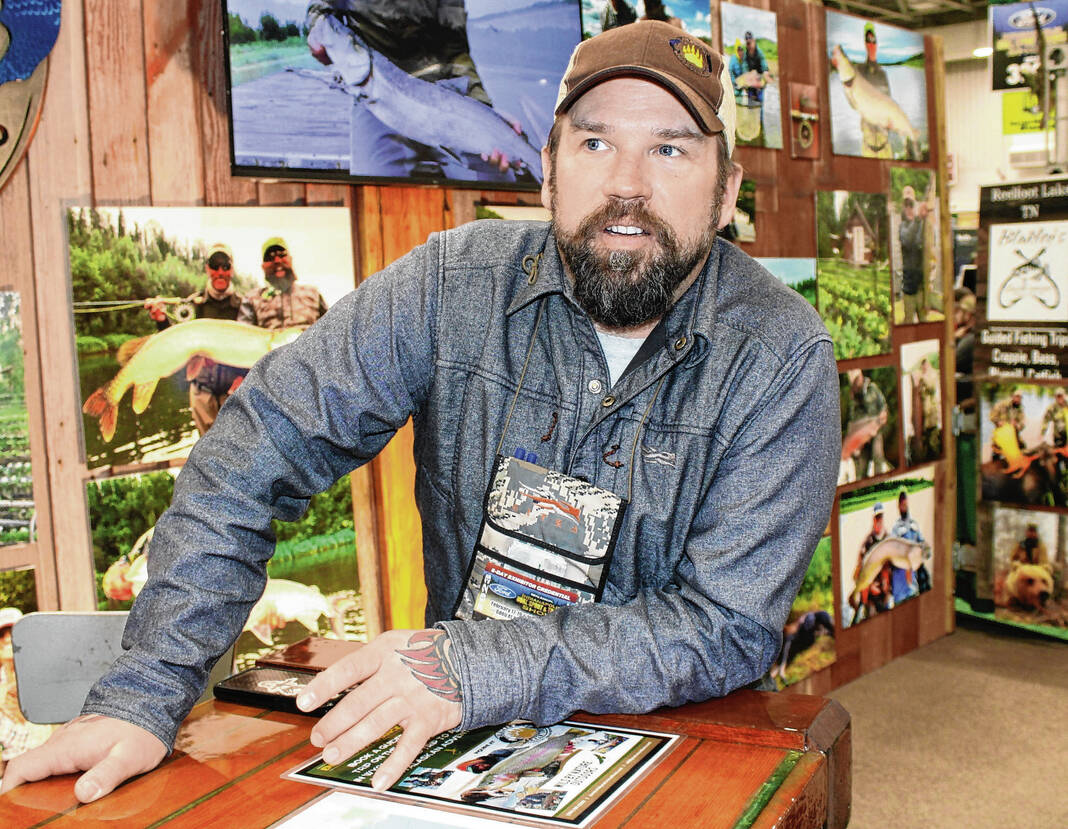
Dan Paull points to a photo of a client’s massive moose kill on a hunting trip near Sleetmute, Alaska.
Lew Freedman | The Tribune

Alaskan Adventures guide Dan Paull manning his booth at the Indianapolis Boat, Sport and Travel Show.
Lew Freedman | The Tribune

The only Alaska outfitter at the 67th annual Indianapolis Boat, Sport and Travel Show, Dan Paull had an eye-catching booth.
Lew Freedman | The Tribune

Alaskan Adventures guide Dan Paull manning his booth at the Indianapolis Boat, Sport and Travel Show.
Lew Freedman | The Tribune
INDIANAPOLIS — Dan Paull’s mission at the Indianapolis Boat, Sport and Travel Show was to make the dreams come true for Hoosiers who always wanted to hunt or fish in Alaska.
Come to “the middle of nowhere” was his sales pitch to hunt for black bears or fish for salmon on the Holitna River near Sleetmute. Leave behind tall buildings, heavy traffic and your neighbors — you might not see a stranger for a week — to lose yourself in the wild.
The proprietor of Alaskan Adventures guide service was the only Alaska operator at the show, and the 46-year-old man who grew up not far from Cleveland, lives in Colorado and works in Alaska was on his fourth expedition to Indianapolis.
Paull was fishing for Indiana clients to take fishing or hunting, appealing to the romance in their souls when the word “Alaska” is mentioned, and their pocketbooks.
His job, as Paull tells his staff of guides, cooks and lodge operators, is not to think about catching fish per se but to think of “making memories” for visitors. Get yourself to Anchorage and Paull’s people will pick you up in a small plane and fly you 238 miles southwest to the kind of emptiness of terrain that still makes up the nation’s largest state.
“I’ve got some good clients out of this area,” Paull said of Indianapolis and vicinity.
Sleetmute, with less than 100 people, is down the block on the Kuskokwim River, the major body of water in the area. But the Alaskan Adventures lodge is its own entity so remote anglers and hunters are not going to be mingling with locals.
“The possibility of running into someone are slim and none,” Paull said.
The possibilities of running into five types of salmon, Chinook, coho, chum, pink and sockeye, Arctic char, grayling, sheefish, pike or Dolly Varden on the Holitna, or moose, black or grizzly bears on land, are much greater, depending on the goal of pursuit at $4,000 to $6,000 per person a week.
Much of the fishing in Indiana revolves around crappie, striped and hybrid bass, catfish and species that will fit easily into a cooler in hefty numbers. As Paull stood at his booth, he was surrounded by blown-up photographs of anglers weighted down, arms sagging, as they posed with 30-pound, feet-long catches.
Chinook also are called kings, but Alaska king returns have been in flux recently, not showing up in the numbers they used to and not being caught at sizes that used to be common. On the other side, “sockeye runs are getting bigger and bigger,” Paull said. “It’s nature and there’s nothing anybody can do about it.”
Paull grew up on an Ohio farm, and he compares his guiding year to farming. Trying to lure people into signing up for Alaskan Adventures is “planting my seeds. Harvest time is when people fish.”
The fishing season for him in the north is from early June into early September, and anglers don’t need a passport the way they would visiting Canada.
The guide service’s splashy display caught the interest of many, as did his companion, a 7-year-old griffon named Matooka.
Delmar Razor, 86, from New Castle, said he regularly fishes for bluegill, crappie and bass in Indiana’s Blue River, on farm ponds and at local parks.
Razor said, “I’ve been fishing since I could walk,” but still has the itch to fish Alaska just once. “My favorite fish, if I’m not going to eat it, is smallmouth.”
Razor’s eyes widened a bit when Paull translated the Alaska fishing opportunity into facts and figures.
“We’ll catch 40 to 60 northerns (pike) a day,” Paull said.
A middle-aged man exploring Paull’s booth said he wanted to plan an Alaska fishing trip with two adult sons. He grabbed a brochure as one son, Weston Tolley, said Alaska had long been on his mind.
“The openness of it,” Tolley said, “the freedom of it.”
That is all part of the experience Alaska offers, fishing or hunting. Sometimes, Paull said, he must chase away curious bears when people are fishing. Then later in the fall, he might be leading curious people to a hunting area to pursue Alaska’s big game.
Alaskan Adventures has a separate hunting camp along the shore of the Holitna about 100 miles from the lodge, and the hunters are motored down the river. Once, Paull had two brothers from Illinois each seeking to bag big moose.
Paull called in a moose to within 20 yards, providing a shot for the first brother. The man’s aim was true, and the big animal went down. Just as he was receiving congratulations, the moose rose to its feet again. A second shot was accurate. The moose got up again, however. A third shot hit the moose, and the hunting party cautiously approached it lying on the ground. Finally, Paull finished off the kill with his handgun.
“He stayed down that time,” Paull said.
When measured, the massive rack was 63 inches.
A day later, in pouring rain, the man’s brother scored with his own moose, this one’s rack measuring 61 inches. These moose probably weighed around 1,800 pounds, Paull said.
It is not legend or myth, or just talk, that it seems everything is bigger in Alaska.
Much of the fishing is catch and release, and only once in awhile will a fish caught on the river head to the table for a meal that day. Paull himself doesn’t even tell any fish stories on himself. Twice, he said, he was named the International Game Fish Association guide of the year because women established world records for catching different species on different types of tackle on the Holitna River.
“As a guide, I fish every day through my clients,” Paull said. “They do what I tell them to do and reel it in. To me, that’s where my joy comes from, where I get my kicks.”
But Paull receives personal satisfaction in other ways from his guiding activities. Clients continue to be sent Alaskan Adventures emails and newsletters after going into the field with the company.
Sometimes, Paull said he gets a message from a spouse for a sad reason. The hunter or angler has passed away and the surviving member of the couple asks to be removed from the list. However, one note also said, “He did speak many a time about what a great experience he had.”
A fishing client came to the Holitna in 2019, then in 2021 returning with a party that included his son and his son’s wife and two grandsons. The woman suffered from a degenerative disease that made it difficult for her to move around.
The trip was a challenge, Paull said, but the woman caught “lots of big fish. Everything was epic. Maybe she’ll never be able to go again.”
This was one trip where memories were definitely made.
